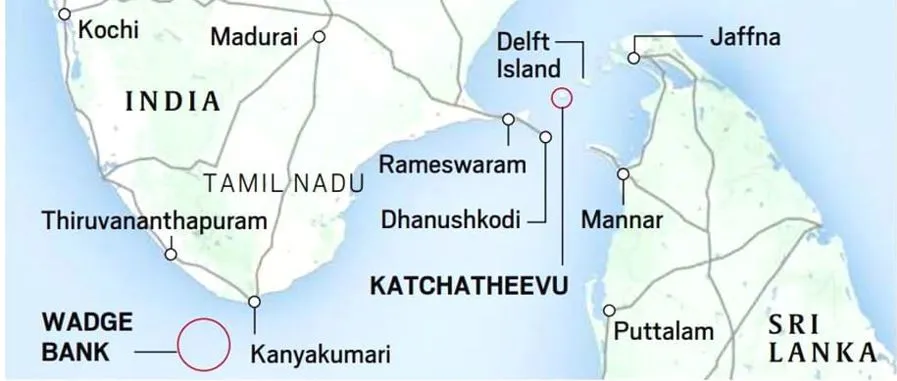

13th May 2025 (13 Topics)
Mains Issues
Context
Prime Minister Narendra Modi addressed the nation following Operation Sindoor, a retaliatory strike conducted by India against Pakistan in response to the 22 April Pahalgam terror attack. In a significant policy assertion, he declared that “no nuclear blackmail will be tolerated by India”. India would no longer be deterred by Pakistan’s nuclear capabilities, which had long been perceived as a shield for cross-border terrorism.
Pakistan’s Nuclear Weapons Capability
- Nuclear Doctrine and Policy: Pakistan does not adhere to a No First Use policy, meaning it reserves the right to use nuclear weapons first if it perceives a serious threat to its sovereignty or national survival.
- Command and Control Structure: Pakistan’s nuclear arsenal is controlled by the National Command Authority (NCA), which is officially chaired by the Prime Minister.
- Nuclear plants in operation in Pakistan: Pakistan has six operable reactors.
- Chashma Nuclear Power Plant 1 (C-1)
- Chashma Nuclear Power Plant 2 (C-2)
- Chashma Nuclear Power Plant 3 (C-3)
- Chashma Nuclear Power Plant 4 (C-4)
- Karachi Nuclear Power Plant (K-2)
- Karachi Nuclear Power Plant (K-3)
- Nuclear Delivery Systems: Pakistan has developed a wide range of delivery systems, though it does not yet have a fully operational nuclear triad.
- Land-based missile systems include Shaheen I and II, Ghauri, and the recently tested Ababeel missile, which is reported to be capable of carrying Multiple Independently Targetable Reentry Vehicles (MIRVs). The short-range Nasr (Hatf-IX) missile is Pakistan’s tactical nuclear weapon, intended for battlefield use.
- Air-based delivery systems include F-16s and Mirage aircraft, which have been modified to carry Ra’ad air-launched cruise missiles (ALCMs) and free-fall nuclear bombs. The Ra’ad has a range of about 350 km, offering strategic strike options within the region.
- Sea-based capability is still under development. Pakistan has tested the Babur-3 submarine-launched cruise missile (SLCM), with a range of approximately 450 km, from an underwater platform. However, it does not yet possess a nuclear-powered ballistic missile submarine (SSBN), meaning its second-strike capability remains limited and under development.
- Nuclear Weapons Storage & Airbases: Sargodha Weapons Storage Complex, Sargodha Air Base, Shahbaz Air Base (Jacobabad)
- Uranium Enrichment & Nuclear Facilities: Kahuta, Khushab, Chashma, Wah, Nilor, Fateh Jang, Garhwal
- Pakistani missiles capable to carry nuclear warheads: Shaheen-I/A (Hatf-4), Nasr (Hatf-9), Abdali (Hatf-2), Ghaznavi (Hatf-3), Ghauri (Hatf-5) and Shaheen-2 (Hatf-6) missiles.
- Estimated Nuclear Arsenal: As of 2025, Pakistan is estimated to have around 170 nuclear warheads.
Nuclear Policy/Doctrine
|
Aspect |
India |
Pakistan |
|
Declared Doctrine |
No First Use (NFU) — India pledges not to use nuclear weapons unless first attacked by nuclear weapons. |
First Use (Conditional) — Pakistan reserves the right to use nuclear weapons first, especially if its existence is threatened. |
|
Posture |
Credible Minimum Deterrence — Aimed at deterring adversaries, not warfighting. |
Full-Spectrum Deterrence — Includes tactical and strategic nuclear options to counter conventional and nuclear threats. |
|
Strategic Messaging |
Nuclear use only in retaliation; any nuclear strike (tactical or strategic) will lead to massive retaliation. |
Emphasizes nuclear deterrence in response to India's conventional superiority; threats occasionally publicized by political figures. |
India’s nuclear policy
|


Mains Issues
Context
On International Nurses Day (May 12), the World Health Organization (WHO), along with the International Council of Nurses (ICN) and other partners, released the State of the World’s Nursing 2025 (SoWN) report. This report provides a global snapshot of the nursing workforce, examining data from 194 countries and reflecting on trends since the previous report in 2020.
Key Highlights from the Report
- Growth in Nursing Workforce (but Unequal Distribution)
- The global nursing workforce increased from 9 million (2018) to 29.8 million (2023).
- However, 78% of all nurses are concentrated in countries that represent only 49% of the global population, revealing a major imbalance.
- Many low-income and middle-income countries (LMICs) still struggle with nurse shortages, affecting their ability to deliver basic healthcare services.
- Underserved region:
- The global nursing shortfall has reduced from 2 million (2020) to 5.8 million (2023). By 2030, it may fall to 4.1 million—but this masks regional disparities.
- Sub-Saharan Africa, parts of Asia, and conflict-affected regions remain severely underserved.
- Graduation vs Employment Mismatch in LMICs: Many poor countries are increasing the number of nursing graduates, but these gains are often wiped out by:
- High population growth
- Insufficient job creation
- Low government spending on health
- Ageing Workforce in Rich Countries
- In high-income countries, a significant portion of nurses is nearing retirement age.
- 19% of global nurses are expected to retire by 2035, with some countries facing higher rates than they can replenish.
- International Migration and Dependency
- 1 in 7 nurses globally are foreign-born.
- In high-income countries, this rises to 23%, showing heavy dependence on international recruitment.
- Low-income countries, ironically, lose nurses to richer nations while facing shortages themselves.
- Working Conditions and Mental Health: Only 42% of countries have mental health support systems for nurses. COVID-19 and increasing workloads have led to burnout, trauma, and stress—especially in underfunded settings. Improving well-being and work-life balance is essential to retain talent.
- Gender and Equity: 85% of the global nursing workforce are women. Yet, gender pay gaps, limited leadership roles, and underrepresentation in policy decisions continue to undermine gender equity in healthcare professions.
- Rise in Advanced Practice Nursing: 62% of countries now recognize Advanced Practice Nurses (APNs)—specialist nurses who can deliver higher-level care. These roles help expand access to health services, especially in rural and underserved areas.
- Leadership and Regulation: 82% of countries have a senior government nursing officer, but leadership training remains limited in low-income countries (only 25% offer structured development). Strong leadership is key to guiding nursing policy and workforce planning.
Relevance for India
- India has increased the number of nursing institutions and graduates, but still faces:
- Urban-rural disparities in nurse availability
- Poor working conditions in public facilities
- Limited career advancement pathways for nurses
- Investing in public sector recruitment, training, and retention is crucial to reduce outmigration and improve rural health access.
- India should also build stronger systems for nursing leadership, mental health support, and primary care deployment.
Policy Priorities for 2026–2030
The report outlines a roadmap for countries to address gaps and inequalities:
- Invest in creating nursing jobs, especially in low-resource regions.
- Strengthen domestic nursing education and align it with health system needs.
- Ensure better pay, safer working conditions, and mental health support.
- Expand Advanced Practice Nursing and update regulations accordingly.
- Promote gender equity, particularly in leadership roles.
- Prepare nurses for climate-related health challenges.
- Use digital tools and technologies to boost efficiency and reach.
- Ensure equitable access to nursing leadership training across all countries.


Mains Issues
Context
In a surprise move, the United States and China agreed to roll back major portions of their tariff war in a temporary deal that marks the most significant thaw in their trade tensions since 2018. The deal is a 90-day truce, with both countries slashing tariffs and pausing non-tariff retaliatory actions.
Brief Background
- The US-China trade war began in 2018. The US imposed steep tariffs citing:
- Unfair trade practices by China
- Intellectual property theft
- Technology transfer issues
- Massive trade deficits
- Escalation (2018–2023): China responded with its own tariffs. Both countries imposed duties on hundreds of billions of dollars of goods.
- Over time, tariffs increased:
- US tariffs peaked at 145% on select Chinese goods.
- Chinese tariffs rose to 125% on US imports.
What has been agreed upon?
- Tariff reduction: The US has agreed to reduce its tariffs on Chinese goods from 145% to 30%. China will cut its tariffs on US goods from 125% to 10%.
- Time frame: This rollback is valid for 90 days from May 14, 2025, during which both sides will continue negotiations.
- Non-tariff measures: China has also agreed to suspend:
- Export restrictions on critical minerals (including rare earth elements).
- Anti-monopoly investigations on American firms like DuPont.
- Use of “unreliable entity list” against US companies.
- Exceptions: The US has retained a 20% levy related to fentanyl control, aiming to pressure China to act against illegal opioid trade.
Why are tariffs controversial?
- Impact on economies:
- The US economy witnessed its first quarterly contraction since early 2022 as importers rushed to beat high tariffs.
- China’s exports to the US declined sharply, affecting its manufacturing sector. April 2025 saw Chinese factory output shrink at the fastest pace in 16 months.
- Impact on global trade and markets:
- The trade war disrupted global supply chains, particularly in electronics and chemicals.
- It increased costs for consumers and businesses.
- Investor confidence was shaken globally, triggering stock market volatility and recession concerns.
What is a trade war?
|


Mains Issues
Context
The 83rd session of the International Maritime Organisation ‘s Marine Environment Protection Committee (MEPC-83) discussed introducing a Market-Based Measure (MBM) to curb shipping emissions through a global levy, marking a potential first in mandatory sector-wide carbon pricing.
Key-highlights of the Session
- The MEPC-83 session marked a critical step by agreeing in principle to introduce a Market-Based Measure (MBM) to reduce greenhouse gas (GHG) emissions from international shipping.
- Global Emissions Levy: The committee supported moving towards an emissions pricing mechanism, where shipping companies would pay a set fee per tonne of CO? emitted.
- This would make international shipping the first global sector with a universal carbon pricing structure, if adopted.
- The MBM framework is intended to help meet the goals of the IMO’s Revised GHG Strategy, which aims to achieve:
- Net-zero GHG emissions from international shipping by or around 2050.
- Intermediate checkpoints: 20-30% reduction by 2030 and 70-80% by 2040, compared to 2008 levels.
- The committee agreed to finalise the MBM design and adopt a legally binding measure by 2025.
What Were the Positions of Different Countries and Blocs?
- Oil-exporting nations, led by Saudi Arabia, opposed the move. Their primary concern was to protect their fossil fuel-based economies.
- Small Island Developing States (SIDS) and Least Developed Countries (LDCs) supported a strong carbon levy, hoping to channel revenues into green development and climate resilience.
- China and other major shipping nations backed minimal levies, seeking to protect their competitive advantage in global trade while slowly transitioning to alternative fuels.
- Scandinavian countries, such as Norway, sought recognition for their early investments in clean shipping technologies, proposing credit systems to reward past efforts.
- Brazil pushed for a rapid transition to methanol as a marine fuel.
- Maritime powers like Greece remained sceptical about the levy, citing concerns about economic feasibility and implementation complexity.
What Does This Mean for India?
India is expected to benefit in multiple ways from the new emissions framework:
- Short-Term Impact: According to UNCTAD estimates, India’s shipping logistics costs may increase by only 5–8% by 2030 and up to 33–35% by 2050. However, the actual trade volumes are unlikely to be significantly affected.
- Limited Exposure: India operates 236 large ships, but only 135 are involved in international voyages, which are subject to the MBM. Domestic fleets are not covered by this framework.
- Fuel Cost Increase: India currently spends about $400 million per year on ship fuel. This may rise by approximately $108 million by 2030—a manageable increase in the context of India’s growing economy.
- Green Hydrogen Opportunity: India’s National Hydrogen Mission aims to make the country a global exporter of green fuels. Indian hydrogen standards already meet IMO’s emission thresholds, making it eligible for reward mechanisms under the levy system.
- Strategic Ports: Indian ports such as those in Gujarat and Andhra Pradesh are preparing to offer green hydrogen bunkering services, placing India at the forefront of future maritime energy hubs.
Current State of India’s Shipping Industry
- India operates a fleet of around 1,500 merchant vessels, including about 236 ships above 5,000 gross tonnage. However, only 135 of these larger vessels are engaged in international voyages, which makes them subject to global decarbonisation measures like the IMO’s proposed emissions levy.
- India’s Maritime Trade Dependency: Roughly 95% of India’s trade by volume and around 70% by value is carried by sea. While India owns and operates a domestic fleet, a significant portion of trade is still dependent on foreign-flagged vessels.
- India currently spends approximately USD 400 million annually on marine fuel for its international fleet. If decarbonisation measures are implemented (like the MBM), this could increase by around USD 108 million by 2030—a manageable burden in relation to overall trade volume.
- MBMs apply only to international shipping. India’s coastal and domestic shipping sector, which plays a key role in regional logistics, remains outside the purview of these global emissions levies.
Why the Global Shipping Industry is a major polluter?
- Heavy use of Fossil Fuels: Ships predominantly run on heavy fuel oil (HFO) or marine diesel—both high in carbon content. These fuels emit large quantities of CO?, sulfur oxides (SOx), nitrogen oxides (NOx), and particulate matter, contributing significantly to air pollution and climate change.
- Sheer Scale of Operations: Global shipping handles over 80% of world trade by volume, operating across long distances with large, fuel-intensive vessels. This makes it inherently energy- and emissions-intensive, even when compared to other transportation sectors.
- Difficulties in Decarbonisation: Unlike road or rail, shipping lacks cost-effective, scalable alternatives to fossil fuels. Clean technologies like green hydrogen, ammonia, or methanol are in nascent stages and face infrastructural, technical, and financial hurdles.
- International Nature of Shipping: Ships frequently cross multiple jurisdictions. This complicates emissions regulation and enforcement, as no single country is fully accountable—creating a regulatory gap in climate governance.
- Impact
- The shipping sector emits approximately one billion metric tonnes of CO? annually, accounting for about 8% of total global greenhouse gas emissions.
- If it were a country, it would be the sixth-largest emitter globally—between Germany and Japan.
- Apart from greenhouse gases, shipping causes acid rain (due to SOx and NOx) and contributes to black carbon pollution, which accelerates the melting of Arctic ice.


Prelims Articles
Context
The Union Ministry of Petroleum and Natural Gas has invited bids for hydrocarbon exploration near Wadge Bank, south of Cape Comorin in Tamil Nadu, under the Hydrocarbon Exploration and Licensing Policy (HELP). This has sparked strong opposition from local fishermen and environmental groups, who fear the project will harm marine biodiversity and fishing livelihoods in a highly productive and ecologically sensitive zone.
What is Wadge Bank?
- Wadge Bank is a shallow, ecologically rich part of the ocean floor in the Indian Ocean.
- It is known for its abundant fishery resources and high marine productivity.
- Location: South of Cape Comorin (Kanniyakumari), extending into the Indian Ocean.
- Wadge Bank is a continental shelf area that creates ideal conditions for fish breeding due to upwelling, nutrient-rich waters, and suitable temperatures.
- It supports the fishing communities of multiple Tamil Nadu districts—Kanniyakumari, Tirunelveli, Thoothukudi, Ramanathapuram—and parts of Kerala.
- Strategic Value: It also acts as a natural barrier, absorbing shockwaves from oceanic disturbances like tsunamis and cyclones, reducing disaster vulnerability for the Tamil Nadu coastline.



Prelims Articles
Context
The Karnataka government has launched B-SMILE with an initial Rs 7,000 crore commitment to fast-track major infrastructure projects in Bengaluru, marking a key step under the upcoming Greater Bengaluru Governance Act, 2024.
What is B-SMILE?
- Bengaluru Smart Infrastructure Limited (B-SMILE) is a newly created Special Purpose Vehicle (SPV) launched by Karnataka to plan, fund, and implement large-scale infrastructure projects in Bengaluru.
- This initiative marks a shift from fragmented urban planning to a centralised, professionally governed body focused on long-term urban transformation, especially in a rapidly expanding and traffic-congested city like Bengaluru.
- B-SMILE is not just another civic body. It is a dedicated company, fully government-owned but designed to attract private investment as well, giving it the flexibility to execute big-ticket projects outside routine bureaucratic processes.
- Need: Bengaluru has long struggled with: Traffic congestion, uncoordinated infrastructure, slow project implementation, overlapping authorities among BBMP, BDA, BWSSB, etc. To overcome these challenges, B-SMILE has been designed as a central executing body for all major infrastructure projects in the city, especially those that span across multiple administrative zones.
- B-SMILE will be governed by an 11-member Board of Directors, with a full-time CEO (an IAS officer).
- Other similar projects:
- Smart City SPVs
- Delhi Mumbai Industrial Corridor Development Corporation (DMICDC) – Central Govt
- Mumbai Metropolitan Region Development Authority (MMRDA) – Maharashtra
- Chennai Unified Metropolitan Transport Authority (CUMTA) – Tamil Nadu
- Ahmedabad Urban Development Authority (AUDA) – Gujarat


Prelims Articles
Context
India’s embassy in Beijing confirmed that the Indian government has formally taken up the issue of export restrictions on germanium with Chinese authorities. This follows grievances raised by Indian industry players affected by China's tightening control over exports of certain critical minerals, particularly germanium, which is essential for electronics, semiconductors, fiber optics, and solar panels.
About
- Germanium(Ge) is a metallic element with high conductivity and thermal conductivity, which makes it an important component in the semiconductor industry.
- Germanium wafers are thin, circular slices of pure germaniumthat serve as the foundation for many electronic devices.
- Germanium is a metalloidthat possesses metal and nonmetal properties.
- While germanium is not classified as a rare earth element, it plays a crucial role in high-technology industries.
- Ge is a metallic element used in:
- Fiber optic cables (as germanium dioxide in preform cores)
- Infrared optics
- Solar photovoltaic cells (especially for satellites and space applications)
- It is critical for high-tech industries, and its supply is concentrated in China, which accounts for over 50% of global production.
- India is highly dependent on imports for most critical minerals, including germanium and gallium.
- Clemens Winkler, a German scientist, discovered germanium in 1886.


Prelims Articles
Context
The Ministry of Agriculture and Farmers Welfare reported a significant increase in the sowing of paddy, pulses, coarse grains, oilseeds, and vegetables (onion, potato, tomato) during the ongoing Kharif season (2024–25).
Key Findings from the Ministry’s Update:
- Increase in Kharif Sowing (as of May 2025):
|
Crop Type |
2023–24 Area |
2024–25 Area |
Net Increase |
|
Paddy |
28.57 lakh ha |
32.02 lakh ha |
+3.44 lakh ha |
|
Pulses |
18.47 lakh ha |
20.67 lakh ha |
+2.20 lakh ha |
|
? Moong |
- |
- |
+1.70 lakh ha |
|
? Urad |
- |
- |
+0.50 lakh ha |
|
Onion |
9.76 lakh ha |
12.58 lakh ha |
+2.82 lakh ha |
|
Potato |
- |
- |
+0.47 lakh ha |
- Tomato sowing is ongoing smoothly along with onion.
Paddy (Rice) Cultivation:
- Season: Grown predominantly in Kharif season (June–October), some regions grow in Rabi.
- Top producing states: West Bengal, UP, Punjab, Andhra Pradesh, Tamil Nadu.
- Water-intensive crop: Requires flooded fields; dependent on monsoons or irrigation.
- Government Support:
- MSP (Minimum Support Price)
- Procurement through FCI
- PMFBY (Crop insurance)
- NFSM-Rice under National Food Security Mission
Pulses Cultivation:
- India is the largest producer and consumer of pulses globally.
- Major Pulses: Moong (Green gram), Urad (Black gram), Arhar (Pigeon pea), Gram (Chickpea), Lentils.
- Sown in both Kharif and Rabi seasons.
- Top producers: Madhya Pradesh, Maharashtra, Rajasthan, UP, Karnataka.
- Government Support:
- NFSM-Pulses
- MSP and Price Stabilization Fund
- Pulse buffer stock to control prices
- Promotion of climate-resilient pulse varieties


Prelims Articles
Context
The Musa indandamanensis, a wild banana species endemic to the Andaman and Nicobar Islands, has produced the world’s longest banana infructescence (fruit bunch axis) — measuring about 4.2 metres. This marks a significant botanical record and sheds light on the rich but lesser-known biodiversity of the Andaman and Nicobar Islands.
What is an infructescence?
- Infructescence is the fruiting structure (or fruit bunch) that develops from an inflorescence (flower cluster).
- In bananas, it’s the long axis bearing all the banana fruits.
- Typically, the infructescence of cultivated bananas is about 1 metre
- This wild banana species has an infructescence of 2 metres, the longest ever recorded.

About the Species: Musa indandamanensis
|


Prelims Articles
Context
The Supreme Court order issued show-cause notices to Delhi government officials, the MCD commissioner, for allegedly violating the 1996 Supreme Court directive by approving a housing project in Morphological Ridge, an ecologically sensitive area, without the required clearances.
About
- The Morphological Ridge is part of the larger Delhi Ridge, which marks the tail end of the Aravalli mountain range.
- This ridge stretches approximately 35 kilometers from Mahipalpur in the southwest to Wazirabad in the northeast of Delhi.
- The Morphological Ridge, though not officially designated as forest land, shares similar ecological features with the main Delhi Ridge, making it an important part of the region’s environmental landscape.
- Ecological Importance: The Morphological Ridge plays a critical role in maintaining Delhi’s ecological balance. The area is characterized by:
- Rocky outcrops and shallow soils.
- Dry thorn forests with drought-resistant plant species like bistendu and dhak.
- Uncultivable rocky hills, often referred to as gair mumkin pahad in revenue records.
- These features contribute to the Ridge's role as a natural green lung for Delhi, helping to:
- Absorb pollutants and reduce air pollution.
- Prevent desertification and mitigate the effects of sandstorms.
- Provide a habitat for native flora and fauna, contributing to biodiversity.
- Legal and Regulatory Framework: The 1996 Supreme Court Directive in the case M.C. Mehta vs. Union of India established clear guidelines to protect ecologically sensitive areas like the Delhi Ridge and its extensions, including the Morphological Ridge. The directive specifically:
- Bans encroachment and non-forest use without prior Court approval.
- Requires approval from the Ridge Management Board (RMB) and the Central Empowered Committee (CEC) before any changes in land use.
- Despite not being officially designated as a Reserved Forest under the Indian Forest Act, 1927, the Ridge and its extensions are afforded protection through these legal mechanisms. This regulatory framework ensures that any urban development in the area must undergo thorough scrutiny to prevent damage to the ecosystem.


Editorials
Context
A ceasefire agreement has been announced between India and Pakistan. While seen as a de-escalatory step, it remains fragile due to Pakistan’s internal military dominance and India’s historical aversion to external mediation. The US has claimed involvement in facilitating the ceasefire, which India is unlikely to endorse.
India’s Stand on Mediation and Historical Lessons
- Consistent Rejection of Third-Party Mediation: India firmly rejects external intercession in bilateral matters, especially on Kashmir. This policy is rooted in India's experience post-1947–48 when the US-UK bloc at the UNSC adopted a pro-Pakistan stance, undermining India's legal arguments.
- Cold War-Era Western Pressure on India: After the 1962 Sino-Indian War, India was diplomatically pressured by the US and UK to negotiate with Pakistan. However, despite inconclusive talks, this attempt highlighted India’s vulnerability to external agendas during periods of military weakness.
- Simla Agreement and Legal Interpretation Conflicts: In 1972, the Simla Agreement institutionalized bilateralism, but the phrase “other peaceful means” has been interpreted differently. While Pakistan views it as permitting multilateralism, India categorically denies any such allowance.
US Role and India’s Strategic Autonomy
- Trump Administration’s Misreading of India’s Policy: Despite US claims that Vice President J.D. Vance and Secretary of State Marco Rubio facilitated the ceasefire, India's rejection of US mediation indicates a fundamental gap in American understanding of India's geopolitical posture.
- Historical Distrust of UNSC and Western Diplomacy: India’s earlier reliance on UNSC interventions — especially in the 1947–48 war — led to disillusionment, shaping a strong doctrine of strategic autonomy in foreign policy that resists Western arbitration.
- Kashmir and Domestic Political Consensus: There is rare political consensus in India against internationalizing the Kashmir issue. Any move to re-engage the UN or external mediators would be politically untenable within India’s national security framework.
Strategic Calculus of Pakistan and Military Influence
- Pakistan’s Tactical Use of Ceasefire: The ceasefire gives Pakistan a temporary reprieve amid internal crises—economic instability, dependence on Chinese financing (via CPEC), and another IMF bailout, making prolonged conflict unsustainable.
- Role of the Pakistani Military Establishment: Despite a civilian government, policymaking remains dominated by the army. General Asim Munir, the current COAS, is known for his hardline stance toward India, suggesting that peace overtures are tactical, not strategic.
- Credibility of Indian Normalcy Narrative Challenged: Through proxy warfare, Pakistan has managed to expose the gap in India’s narrative of restored normalcy in Kashmir, influencing perceptions in the international community and among strategic observers.
Practice Question
Q. India has consistently rejected third-party mediation in its bilateral disputes with Pakistan. Critically examine this stance in light of recent ceasefire developments, historical UNSC dynamics, and evolving global geopolitical pressures.


Editorials
Context
The increasing centralisation by regulatory bodies like the UGC, ideological interference, and the corporatisation of university spaces is leading to growing threats to academic freedom and institutional autonomy in Indian higher education. It reflects a broader crisis in higher education governance and the shrinking space for dissent and critical thinking.
Centralisation and Bureaucratic Control over Academia
- Loss of University Autonomy: Centralised bodies like the University Grants Commission (UGC) and policies like the National Education Policy (NEP) now heavily influence syllabus design, appointments, and research direction, undermining academic judgment and institutional independence.
- Standardisation of Curricula: Uniformity in syllabus across institutions eliminates regional, disciplinary and ideological diversity, leading to intellectual stagnation and discouraging radical or alternative approaches to knowledge.
- Suppression of Dissent: Universities are increasingly turned into instruments of state control, where referencing critical thinkers (e.g., Noam Chomsky) or critiquing nationalism may attract penalties, surveillance, or administrative backlash, curbing democratic expression.
Corporatisation and Market-Driven Academic Priorities
- Knowledge as Commodity: Universities are being restructured on corporate models, where the focus shifts from public service to profit-generation, rankings, and brand visibility, thereby eroding the educational ethos.
- Marginalisation of Social Sciences: Disciplines like philosophy, literature, and political science are deprioritised as financially unproductive, while business, technology, and engineering dominate funding and institutional priorities.
- Metric-Driven Faculty Evaluation: Academics are now assessed based on publication counts, student ratings, and global rankings, often rewarding performativity and western benchmarks over indigenous or contextual relevance.
Governance Crisis and Ideological Interference
- Managerial Mindset in University Leadership: Vice Chancellors are increasingly drawn from non-academic or corporate backgrounds, promoting efficiency and branding over pedagogical or scholarly engagement.
- Ideological Bias in Appointments: Academic leadership often reflects partisan or ideological leanings, with appointments favouring individuals disconnected from liberal intellectual traditions or critical scholarship.
- Decline of Public Intellectualism: Fear of political reprisal fosters self-censorship among faculty and students, discouraging bold research or critical classroom debates, thus shrinking the space for public reasoning and academic dissent.
Practice Question:
Q. Critically examine the impact of bureaucratic centralisation and market-driven reforms on academic autonomy and intellectual freedom in Indian universities. In your view, how can institutions reconcile regulatory accountability with creative and critical scholarship?


Editorials
Context
Following a rapid escalation of the US-China trade war in early 2025, the two countries have announced a pause in hostilities after two days of negotiations in Geneva. While this move rolls back severe tariff increases made since April 2, it is not a trade deal, and significant trade barriers still remain.
Timeline and Trigger of Escalation
- February Tariffs Spark Conflict: The US imposed 10% tariffs on Chinese goods and 25% on Mexican and Canadian imports in February 2025, citing the fentanyl crisis as a key concern. China retaliated immediately with its own set of counter-tariffs.
- April 2 Reciprocal Tariff Escalation: By April 10, the situation escalated rapidly: the US raised tariffs to 145% on Chinese imports, while China retaliated with 125% tariffs on US goods, essentially approaching a de facto trade embargo.
- Economic Fallout Becomes Evident: The US economy contracted by 3% in Q1 2025, even before the worst effects of the tariff war played out. Both countries were heading toward economic destabilization and loss of investor confidence.
Nature of the Pause and Remaining Barriers
- Partial Rollback of Tariffs: As part of the de-escalation, both sides agreed to cut 115% of the tariff hikes, reducing their import duties on each other to 10% baseline tariffs. However, the US retains an additional 20% fentanyl-related tariff.
- Consumers and Producers Still Burdened: Despite the rollback, US consumers are still facing 30% tariffs on Chinese imports, which continue to strain household budgets and supply chains. Producers also face increased input costs.
- Not Yet a Comprehensive Deal: The current arrangement is not a trade agreement but merely a truce. It only undoes escalation post-April 2, with both sides acknowledging the risk posed to global economic stability.
Strategic and Economic Implications
- Trade Deficit and Strategic Concerns Persist: Trump’s broader rationale includes reversing the US trade deficit and reviving domestic manufacturing, beyond the fentanyl issue. These underlying goals remain unresolved.
- China’s Export-Driven Model Under Pressure: China, heavily reliant on exports and global supply chains, faces significant vulnerability during trade stand-offs, risking domestic economic and political instability.
- Global Supply Chains and Recession Risks: The near-trade embargo status disrupted global manufacturing and supply networks, with ripple effects on third countries and a looming recessionary threat for both economies.
Practice Question
Q. The recent pause in the US-China trade war reflects the precarious balance between geopolitical ambitions and economic interdependence. Critically analyse the implications of such conflicts on global trade architecture and India’s economic strategy.



